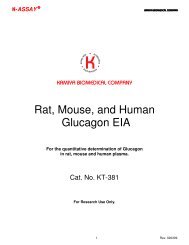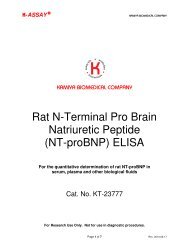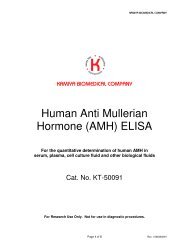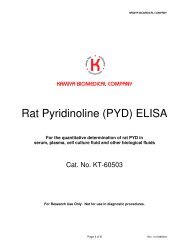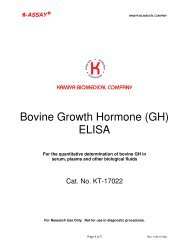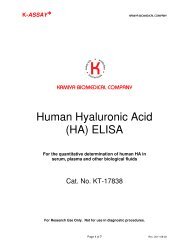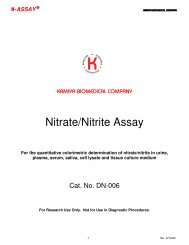Superoxide Dismutase (SOD) Assay - Kamiya Biomedical Company
Superoxide Dismutase (SOD) Assay - Kamiya Biomedical Company
Superoxide Dismutase (SOD) Assay - Kamiya Biomedical Company
You also want an ePaper? Increase the reach of your titles
YUMPU automatically turns print PDFs into web optimized ePapers that Google loves.
K-ASSAY ®<br />
KAMIYA BIOMEDICAL COMPANY<br />
KAMIYA BIOMEDICAL COMPANY<br />
<strong>SOD</strong> <strong>Assay</strong><br />
For the measurement of <strong>Superoxide</strong> <strong>Dismutase</strong> (<strong>SOD</strong>) Inhibition Activity<br />
Cat. No. KT-019 (500 tests/20 samples)<br />
For Research Use Only. Not for Use in Diagnostic Procedures.<br />
1<br />
Rev. 10040019
K-ASSAY ®<br />
KAMIYA BIOMEDICAL COMPANY<br />
PRODUCT INFORMATION<br />
<strong>SOD</strong> <strong>Assay</strong><br />
Cat. No. KT-019 (500 tests)<br />
PRODUCT<br />
The K-ASSAY ® <strong>SOD</strong> <strong>Assay</strong> is for the measurement of <strong>Superoxide</strong> <strong>Dismutase</strong> (<strong>SOD</strong>) inhibition activity.<br />
PRINCIPLE<br />
<strong>Superoxide</strong> <strong>Dismutase</strong> (<strong>SOD</strong>), which catalyzes the dismutation of the superoxide anion (O 2 - ) into hydrogen peroxide and<br />
molecular oxygen, is one of the most important antioxidative enzymes. In order to determine the <strong>SOD</strong> activity, several direct<br />
and indirect methods have been developed. Among these methods, an indirect method using nitroblue tetrazolium (NBT) is<br />
commonly used due to its convenience and ease of use. However, there are several disadvantages to the NBT method,<br />
such as poor water solubility of the formazan dye and the interaction with the reduced form of xanthine oxidase. The<br />
K-ASSAY ® <strong>SOD</strong> <strong>Assay</strong> allows very convenient <strong>SOD</strong> assaying by utilizing KAMIYA BIOMEDICAL COMPANY’s highly watersoluble<br />
tetrazolium salt, WST-1 (2-(4-Iodophenyl)-3-(4-nitrophenyl)-5-(2,4-disulfophenyl)-2H-tetrazolium, monosodium salt)<br />
that produces a water-soluble formazan dye upon reduction with a superoxide anion. The rate of the reduction with O 2 - are<br />
linearly related to the xanthine oxidase (XO) activity, and is inhibited by <strong>SOD</strong>, as shown in Figure 1. Therefore, the IC 50 (50%<br />
inhibition activity of <strong>SOD</strong> or <strong>SOD</strong>-like materials) can be determined by a colorimetric method.<br />
Fig. 1 Principle of the determination of <strong>SOD</strong> activity using <strong>SOD</strong> <strong>Assay</strong> Kit.<br />
2<br />
Rev. 10040019
KAMIYA BIOMEDICAL COMPANY<br />
COMPONENTS<br />
KT-019 (500 Tests)<br />
• 1 x 5 mL WST Solution<br />
• 1 x 100 µL Enzyme Solution<br />
• 1 x 100 mL Buffer Solution<br />
• 1 x 50 mL Dilution Buffer<br />
MATERIALS OR EQUIPMENT REQUIRED BUT NOT PROVIDED<br />
• Plate reader (450 nm filter).<br />
• 96-well microplate.<br />
• 2-20 µL & 20-200 µL pipettes and a multi-channel pipette.<br />
• Incubator.<br />
PROTOCOLS<br />
Preparation of Solutions (for one 96-well plate)<br />
• WST Working Solution<br />
Dilute 1 mL of WST Solution with 19 mL of Buffer Solution. WST working solution is stable for 2 months at 4°C.<br />
• Enzyme Working Solution<br />
Centrifuge the Enzyme Solution tube for 5 sec. Mix by pipeting, and dilute 15 µL of Enzyme Solution with 2.5 mL of<br />
Dilution Buffer. Enzyme working solution is stable at 4°C for 3 weeks.<br />
• Sample Solution<br />
Dilute sample solution with Dilution buffer or saline to prepare sample solution as follows.<br />
Dilution ratio: 1, 1/5, 1/5 2 , 1/5 3 , 1/5 4 , 1/5 5 , 1/5 6<br />
Fig. 2 Preparation of sample solution<br />
3<br />
Rev. 10040019
µ L 200<br />
L<br />
L<br />
* blank 2<br />
L<br />
KAMIYA BIOMEDICAL COMPANY<br />
Table 1: Amount of each solution for sample, blank 1, 2 and 3<br />
µ L 20 Solution<br />
- L<br />
- L<br />
µ L 20<br />
Sample<br />
blank 1 blank sample<br />
3<br />
ddH<br />
20 µ<br />
-<br />
WST Working O 2<br />
200 µ<br />
µ µ 200 200<br />
-<br />
20 µ<br />
µ L 20<br />
L<br />
- -<br />
- -<br />
µ L 20<br />
L<br />
Solution<br />
blank 1: coloring without inhibitor<br />
blank 2: sample blank<br />
blank 3: reagent blank<br />
*If the color of the sample solution is strong, measure blank 2 at each dilution of the sample.<br />
Working Solution Dilution Enzyme<br />
Buffer<br />
20 µ<br />
20 µ<br />
General Protocol<br />
1. Add 20 µL of sample solution to each sample and blank 2 well, and add 20 µL of ddH 2 O (double distilled water) to<br />
each blank 1 and blank 3 well.<br />
2. Add 200 µL of WST Working Solution to each well, and mix.<br />
3. Add 20 µL of Dilution Buffer to each blank 2 and blank 3 well.<br />
4. Add 20 µL of Enzyme Working Solution to each sample and blank 1 well, and then mix thoroughly**.<br />
5. Incubate the plate at 37°C for 20 min.<br />
6. Read the absorbance at 450 nm using a microplate reader.<br />
7. Calculate the <strong>SOD</strong> activity (inhibition rate %) using the following equation.<br />
<strong>SOD</strong> activity (inhibition rate %) = {[(A blank 1 - A blank 3 ) – (A sample - A blank 2 )] / (A blank 1 - A blank 3 )} x 100<br />
** Since superoxide will be released immediately after the addition of Enzyme Working Solution to a well, use a<br />
multi-channel pipette to avoid the reaction time lag of each well.<br />
Inhibition activity can also be determined by a kinetic method. Please determine an incubation time range that<br />
has a linearity of the slope before the assay. A good linearity should be observed up to 20 min. For the<br />
calculation, use the following equation:<br />
<strong>SOD</strong> activity (inhibition rate %) = {[(S1 – S3) – (SS – S2)] / (S1 – S3)} x 100<br />
S1: slope of blank1, S2: slope of blank2, S3: slope of blank3, SS: slope of sample<br />
4<br />
Rev. 10040019
KAMIYA BIOMEDICAL COMPANY<br />
Fig 3. Example of sample and blank arrangement on a 96-well plate<br />
Fig 4. Inhibition curve of Cu,Zn-<strong>SOD</strong> (SIGMA Cat#:S2515)<br />
5<br />
Rev. 10040019
KAMIYA BIOMEDICAL COMPANY<br />
One unit of <strong>SOD</strong> is defined as the amount of the enzyme in 20 µL of sample solution that inhibits the reduction<br />
reaction of WST-1 with superoxide anion by 50%.<br />
Determination of <strong>SOD</strong> Activity<br />
1. Read the dilution ratio at 50% inhibition (IC 50 ) from inhibition curve.<br />
2. Multiply the dilution ratio at IC 50 and at the sample preparation to obtain the <strong>SOD</strong> activity.<br />
Example: Determination of <strong>SOD</strong> activity in erythrocytes<br />
1. Read the dilution ratio at 50% inhibition (IC 50 ) from the inhibition curve (Fig.5). The dilution ratio at IC 50 is 1/1.8.<br />
2. The <strong>SOD</strong> activity before dilution is “1.8 U/20 µL” from the definition above.<br />
3. The <strong>SOD</strong> activity in 1 mL of sample is 1.8 / 0.02 = 90.0 U/mL.<br />
4. Multiply the <strong>SOD</strong> activity calculated above by the necessary dilution ratio for sample preparation. In the case blood is<br />
diluted to 1/120 during the sample preparation, the <strong>SOD</strong> activity in blood in calculated as below.<br />
120 x 90.0 = 10,800 U/mL of blood.<br />
Fig.5 Inhibition curve of erythrocyte<br />
6<br />
Rev. 10040019
KAMIYA BIOMEDICAL COMPANY<br />
Determination of Mn-<strong>SOD</strong> activity<br />
Mn-<strong>SOD</strong> activity can be measured by adding potassium cyanide (final concentration: 1 mmol/L) or dietyldithiocarbamate<br />
(final concentration: 1 mmol/L) to the sample solution. These reagents inactivate Cu, Zn-<strong>SOD</strong> and extracellular-<strong>SOD</strong><br />
activities.<br />
INTERFERENCE<br />
Below shows compatible concentration of possible interfering materials. If sample contains these materials, please dilute the<br />
sample to be below their compatible concentration. Since 2-mercaptoethanol and dithiothreitol cause a significant increase of<br />
the O.D. value, please remove them when sample contains these materials.<br />
Detergents: SDS (0.05%), Tween 20 (0.5%), NP-40 (0.5%)<br />
Solvents: Ethanol (25%), DMSO (5%)<br />
Reducing agents: Glutathione reduced form (1.25 mmol/L), Ascorbic acid (0.1 mmol/L)<br />
Others: EDTA (2 mM), BSA (1%w/v)<br />
PRECAUTION<br />
1. For dilution of sample, use Dilution buffer or saline.<br />
2. The Enzyme solution is separated into two layers. Therefore, omitting the pipetting process will result in inaccurate<br />
experimental results.<br />
3. For an accurate measurement, the use of multiple wells per sample is recommended.<br />
4. Since superoxide will be released immediately after the addition of Enzyme working solution to a well, use a multichannel<br />
pipette to avoid the reaction time lag of each well.<br />
STORAGE<br />
Please store at 4°C. Protect the WST Solution and WST Working Solution from light.<br />
FOR RESEARCH USE ONLY<br />
NOT FOR USE IN DIAGNOSTIC PROCEDURES<br />
KAMIYA BIOMEDICAL COMPANY<br />
12779 Gateway Drive, Seattle, WA 98168<br />
Tel: (206) 575-8068 Fax: (206) 575-8094<br />
Email: LifeScience@k-assay.com<br />
www.k-assay.com<br />
7<br />
Rev. 10040019



